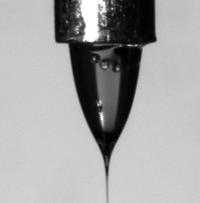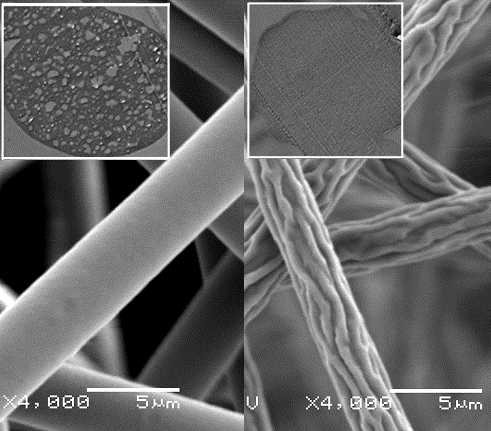Processing and Properties of Electrospun Fibers
| Personnel: | Pradipto Battacharjee, Chia-Ling Pai, Yuxi Zhang |
Electrospinning is a process that employs electrostatic forces to produce polymer fibers, ranging in diameter from microns down to tens of nanometers. It offers a unique opportunity to study the fundamental physics governing the behavior of electrically-driven polymeric jets. The fibers formed via electrospinning also demonstrate a rich variety of physico-chemical properties that are of significant interest in the emergent field of polymer nano-science and technology. The study of these fundamental aspects of electrospinning enables us to better understand what processing conditions are needed to produce the specific structure and properties of electrospun fibers for the vast variety of applications, including tissue scaffolding, highly efficient filtration membranes, nanowires, and functional nanocomposites.

|
Figure 1: Electrospin jet (Outer diameter ~ 1mm) |
Towards that end, we have identified the physical process that sets the length scale for the thinning of the jet in electrospinning [Phys. Rev. Lett. 90, 144502 (2003)]. Based on this knowledge, we designed a two-fluid electrospinneret and demonstrated its utility to make fibers with a core/shell structure, to process fluids that would otherwise be unspinnable, and to make fibers with a smaller terminal diameter than would be possible using a single fluid electrospinneretts [Adv. Mater. 16, 1562, (2004)].
One of the goals we are pursuing in this area is to determine the fundamental physical principles that unite the electro-hydrodynamics of the process to the extensional rheological response of the fluid and thereby to outline the design principles of the electrospinning processes. Having previously developed a model to properly account for non-linear effects such as stretching of the jet and strain hardening, and to describe the evolution of the whipping jet from the onset of the instability to the moment it hits the collector, we have recently discovered a universal scaling of the current measured in electrospinning.

|
Figure 2: (Left) smooth fibers with porous structures (inset); (Right) wrinkled fibers with consolidated structures (inset). |
Regarding the properties of electrospun fibers, we want to understand how the processing conditions affect the morphologies and the mechanical properties of the fibers formed. We are also aiming at studying the electrical properties of electrospun polymeric nanofibers with varied internal and surface functionalities. We have previously identified the role of the axial polymeric stress in determining the morphologies of the fibers formed in electrospinning [Polymer 47, 4789 (2006)], and are in the process of identifying and characterizing the critical parameters that affect surface topographies and internal structures of electrospun polymeric fibers. We have recently reported on the effects of solvent evaporation that give rise to fibers with internal pores and to fibers with wrinkled surfaces as a consequence of an elastic buckling phenomenon [Macromolecules (2009) in press].
updated: 2-25-2009
Webmaster
Copyright Notice